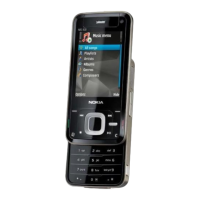General RF troubleshooting
Introduction to RF troubleshooting
Most RF semiconductors are static discharge sensitive
ESD protection must be applied during repair (ground straps and ESD soldering irons).
Pre-baking
These parts are moisture sensitive and must be pre-baked prior to soldering:
• RFIC N7505
• Front End Module (FEM) N7520
• WCDMA PA N7540
Discrete components
In addition to the key-components, there are a number of discrete components (resistors, inductors and
capacitors) for which troubleshooting is done mainly by
visual inspection
.
Capacitors: check for short circuits.
Resistors: check value with an ohm meter.
Note: In-circuit measurements should be evaluated carefully
Measuring equipment
All measurements should be done using:
• An oscilloscope for low frequency and DC measurements. Recommended probe: 10:1, 10Mohm//8pF.
• A radio communication tester including RF generator and spectrum analyser, for example Rohde & Schwarz
CMU200. (Alternatively a spectrum analyser and an RF generator can be used. Some tests in this guide are
not possible to perform if this solution is chosen).
Note: A mobile phone WCDMA transmitter should never be tested with full TX power (only it possible
to perform the measurements in a good RF-shielded room). Even low power WCDMA transmitters
may disturb nearby WCDMA networks and cause problems to 3G cellular phone communication in
a wide area.
Note: All measurements with an RF coupler should be performed in an RF-shielded environment
because nearby base stations can disturb sensitive receiver measurements. If there is no possibility
to use RF shielded environment, testing at frequencies of nearby base stations should be avoided.
Level of repair
The scope of this guideline is to enable repairs at key-component level. Some key-components are not
accessible, i.e. not replaceable. Please refer to the list of Non-replaceable RF components (page 4–8).
General information on RF troubleshooting
The RF frontend solution has two signal paths to the antenna feed points. One signal path is for GSM and
WDCMA 2100 Tx (WCDMA transmitter path) and the second one is for WCDMA 2100 RX (WCDMA receiver path).
This fact has to be considered when connecting measurement equipment to the product.
RM-179; RM-223
RF troubleshooting
Issue 1 COMPANY CONFIDENTIAL Page 4 –5
Copyright © 2007 Nokia. All rights reserved.

